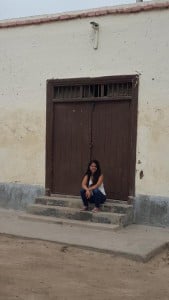Friday night I was invited to the U.S. Embassy in Lima for a live viewing of the soccer match between the United States and Peru. I was expecting a small gathering but as I walked up to the Embassy, I noticed a long line outside. I asked the guy at the end of the line what the line was for, and he responded: “To view the soccer match!” I lined up behind him. He turned around and said, “You need an invitation.” I assured that him I had one.
Apparently, 180 people had been invited, including the national press and local students learning English. As I passed through security, I could hear the vibrant sounds of the Batucada playing in the background and of course, I did a little samba–– an upbeat dance of Brazilian origin performed during Carnival parades.
As I walked in, I felt like a queen. This was the place were my parents had come more than twenty-five years ago to ask for a Visa to purse their American dream. I remember hearing about bank statements and other paperwork they had to bring; I imagined my dad sitting, nervously awaiting his turn. And now, here I am more than two decades later, walking the same grounds as an American, invited to this private event.
Hours later, I confused a man who worked at the Embassy. While conversing with him, I gave a brief bio: I was born in Peru, left as a child, live in the United States; I’m doing a Fulbright grant and have family here and there. He had to stop me and ask: “Wait, are you doing a Fulbright here [in Peru] or in the States?” Fulbright grants in the U.S. are given to American citizens, and it is not common to get a grant to one’s own country of birth since part of the objective is to learn about a new culture. In fact, this had also been the second time I applied. The first time was five years ago, but I was wait-listed.
Well, here I am today, in Peru, an immigrant, in the grey area, not from here or there but in between, a bridge between two cultures—at least that is my hope. Through my Fulbright project on dance, I aspire to continue what I had began with my dance company, Cunamacué, back in the U.S., which is to fuse both Western and Afro-Peruvian dance—a reflection of my own experience as a bicultural, bilingual American. Through my research in Peru, I aim at creating a contemporary development of Afro-Peruvian dance which draws not only on an Afro-Peruvian dance vocabulary, but also on movements inspired by other dances of the African Diaspora and modern dance. What was once a memory or romantic thought about Peru (I had learned Afro-Peruvian dance while living in the U.S. and resorted to filling in the blanks with ideas generated by my body) is now real! I am immersing myself in the culture here, taking dance classes, participating in rehearsals, attending performances, teaching dance and living in the community.
My advice to prospective Fulbright U.S. Student Program candidates is to propose a project that you are truly passionate about. Plan a project that you’ve always dreamed of doing and don’t get discouraged if you don’t get it the first time: persist and try again. After all, it worked for me!
Carmen Román is a 2015-2016 Fulbright U.S. Student undertaking research on Afro-Peruvian dance through practice, performance and observation in Lima and El Carmen, Peru. A version of the post below originally appeared on Carmen’s personal blog, Feet on the Soil.


1 Comment
Congrats to you! Great topic & good luck! From one Peruvian American to another, sigue palante!